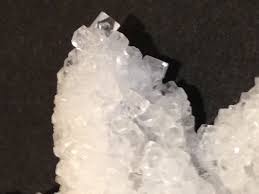AIM: TO LOOK AT THE 7 DIFFERENT TYPES OF CRYSTALS

Salt Crystals

Sugar Crystals

Borax Crystals
7 different crystal shapes

The 7 types of crystals
Type
Number of sides
2 examples
Image
Triclinic
Definition:
of or denoting a crystal system or three-dimensional geometrical arrangement having three unequal oblique axes.
7

Monoclinic
Definition:
of or denoting a crystal system or three-dimensional geometrical arrangement having three unequal axes of which one is at right angles to the other two.
10

Orthombic
Definition:
of or denoting a crystal system or three-dimensional geometrical arrangement having three unequal axes at right angles.
6

Trigonal
Definition:
of or denoting a crystal system or three-dimensional geometrical arrangement having three equal axes separated by equal angles that are not right angles.
10

Hexagonal
Definition:
of or denoting a crystal system or three-dimensional geometrical arrangement having three axes of equal length separated by 60° and a fourth axis of a different length at right angles to these.
8

Cubic
Definition:
denoting a crystal system or three-dimensional geometrical arrangement having three equal axes at right angles.
6

Tetragonal
Definition:
of or denoting a crystal system or three-dimensional geometrical arrangement having three axes at right angles, two of them equal.
12

Explain how the following crystals are formed?
Type
Salt
As the water evaporates from the solution, the Na and Cl atoms begin to bond together, first as single molecules and then the molecules bond together,forming crystals. Every molecule will form the same shape crystal each time it forms. The crystal shape for salt is a cube like a six-sided die.
Sugar
The other is evaporation—as time passes, the water will evaporate slowly from the solution. As the water evaporates, the solution becomes more saturated and sugar molecules will continue to come out of the solution and collect on the seed crystals on the string. The rock candy crystals grow molecule by molecule.
Snowflakes
A snowflake begins to form when an extremely cold water droplet freezes onto a pollen or dust particle in the sky. This creates an ice crystal. As the ice crystal falls to the ground, water vapor freezes onto the primary crystal, building new crystals – the six arms of the snowflake.
Salt Crystals
|
Sugar Crystals
|
Borax Crystals
|
Type
|
Number of sides
|
2 examples
|
Image
|
Triclinic
Definition:
of or denoting a crystal system or three-dimensional geometrical arrangement having three unequal oblique axes.
|
7
| ||
Monoclinic
Definition:
of or denoting a crystal system or three-dimensional geometrical arrangement having three unequal axes of which one is at right angles to the other two.
|
10
| ||
Orthombic
Definition:
of or denoting a crystal system or three-dimensional geometrical arrangement having three unequal axes at right angles.
|
6
| ||
Trigonal
Definition:
of or denoting a crystal system or three-dimensional geometrical arrangement having three equal axes separated by equal angles that are not right angles.
|
10
| ||
Hexagonal
Definition:
of or denoting a crystal system or three-dimensional geometrical arrangement having three axes of equal length separated by 60° and a fourth axis of a different length at right angles to these.
|
8
| ||
Cubic
Definition:
denoting a crystal system or three-dimensional geometrical arrangement having three equal axes at right angles.
|
6
| ||
Tetragonal
Definition:
of or denoting a crystal system or three-dimensional geometrical arrangement having three axes at right angles, two of them equal.
|
12
|
Type
| |
Salt
|
As the water evaporates from the solution, the Na and Cl atoms begin to bond together, first as single molecules and then the molecules bond together,forming crystals. Every molecule will form the same shape crystal each time it forms. The crystal shape for salt is a cube like a six-sided die.
|
Sugar
|
The other is evaporation—as time passes, the water will evaporate slowly from the solution. As the water evaporates, the solution becomes more saturated and sugar molecules will continue to come out of the solution and collect on the seed crystals on the string. The rock candy crystals grow molecule by molecule.
|
Snowflakes
|
A snowflake begins to form when an extremely cold water droplet freezes onto a pollen or dust particle in the sky. This creates an ice crystal. As the ice crystal falls to the ground, water vapor freezes onto the primary crystal, building new crystals – the six arms of the snowflake.
|
No comments:
Post a Comment
To support my learning I ask you to comment as follows:
1. Something positive - something you like about what I have shared.
2. Thoughtful - A sentence to let us know you actually read/watched or listened to what I had to say
3. Something thoughtful - how have you connected with my learning? Give me some ideas for next time or ask me a question.